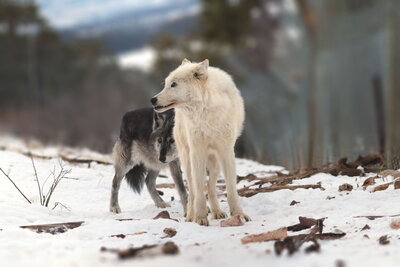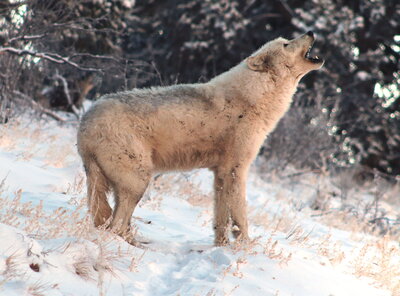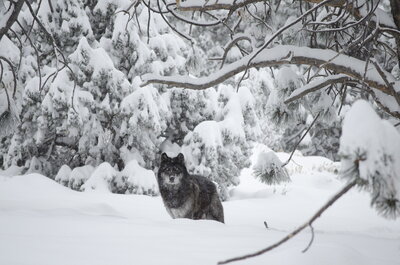"Sanctuary is Not a Place"
By Austin D. Hoffman (Anthropology)
We were sitting on the picnic table outside the staff kitchen, watching a spectacular sunset over the Sangre de Cristo Mountains. As the radiant mosaic of oranges and purples faded to greys and blacks, Tricia and I were reminiscing about the eccentric cast of human and nonhuman characters that had found sanctuary here. We arose from our seats and began to head inside, eager to be embraced by the heat of the wood-burning stove. Then we heard the snarls.

Illiamna and Merlin. By Camille Potts
The guttural tonality indicated this was no mere scuffle, and we knew exactly who it was. We walked briskly up the path toward Merlin and Illiamna, two wolves who had been paired together in the same enclosure earlier that day. We peered through the twelve-foot tall chain-link fence down into the valley and saw Illiamna, the roughly 130-pound male arctic wolf, pursuing Merlin, a female wolfdog of nearly equal size. Something had set Illiamna off, and he was trying to latch onto Merlin’s haunches with his massive jaws. Merlin drew from the vast vocal and embodied language of her species to dissuade him. She emitted every warning sign, but to no avail. The other wolves in neighboring enclosures were howling with frantic alarm. We had to intervene before things escalated.
“I’m gonna go around back and open the rear gate. You go down there and push them up towards me so we can separate Illy. Try to get between them if you can.” Tricia was the lead animal caretaker. She knew the wolves better than anyone, and she had to be the one to open the gate because Illiamna trusted her enough to walk past her. Despite my anxiety I was confident in her leadership. I grabbed the Y-pole outside the gate—an elongated metal rod with a padded forked end used for restraining and controlling the movement of large carnivores—and headed inside. I struggled to maintain balance on the icy hillside while also keeping eyes on the tangled mass of growling fur and fangs a hundred yards away. As I approached, Merlin recognized her chance for escape. She disengaged from Illiamna with such a burst of speed that he couldn’t react quickly enough to give chase, leaving a gap between them that I stepped into.

Illiamna Howling. by Camille Potts
As I planted my feet and extended the Y-pole at a 45 degree angle, I couldn’t help but lock eyes with Illiamna and marvel at him. Here is a creature that, were he in “the wild,” would be hunting caribou, moose and muskoxen. His bite force is twice that of a German-shepherd, and could easily crush my arm. Yet despite his formidable strength, I could see in his dark-golden eyes that he was scared and confused. He recoiled, flattening his ears against his head in a submissive posture. Like his wild brethren, Illy is wary of humans. As he began to probe for a way to get to Merlin, Tricia arrived at the back of the enclosure and opened the gate. He paced laterally, and I mimicked his movements, using the Y-Pole as an extension of my body to prevent him from sneaking past me. We continued this tense interspecies dance for maybe eight minutes, although it seemed like an eternity. Twice he tried to take an angle back to Merlin, but I was able head him off—just barely. He eventually realized I would not relent, and coyly retreated through the upper gate into an empty enclosure. Tricia immediately shut it behind him. They were unharmed. We finally exhaled.
This incident happened this past January at Mission: Wolf (M:W), a non-profit educational sanctuary in the remote foothills of southern Colorado established primarily to care for wolves and wolfdog crosses rescued from the exotic pet trade. It is one of the oldest sanctuaries of its kind in the country, and uniquely, it is operated by a small community of live-in staff and volunteers. In this regard M:W is an intentional community, and shares in a long lineage of counter-cultural social experiments originating in the high deserts of Colorado and New Mexico. I lived here and coordinated the sanctuary’s educational programming from 2016-2018. It is both a centerpiece of my scholarly research, and a place I consider home.

M:W staff pose after processing meat for the wolves
From the moment I relocated from Colorado to central Illinois to begin graduate school, I felt torn between my desire to pursue a Ph.D. and a deep sense of responsibility to M:W and the more-than-human kinship networks I’ve developed there. So I’ve returned every summer to reconnect with my two and four-legged friends, and to help out where I can, whether that be processing livestock donations for the wolves, repairing fences, or giving tours to visitors. These annual trips have become vital to maintaining and nurturing those kinship networks, and also providing me with a much needed respite from the stress of academia. But in summer 2020, I postponed my trip due to COVID-19. I simply couldn’t risk travel, for my own sake and for M:W. If the virus took hold in such a small community, it would be disastrous. I didn’t realize how important going home was to my mental and emotional health until I was prohibited from doing so. In the interest of self-care, I decided to use the winter break to briefly return to M:W. By this time there was more information available about how the virus spread, and the sanctuary had instituted a strict quarantine process to minimize risk.
All of this perhaps seems disconnected from the vignette I opened this reflection with. I share it because it underscores both the practices of care integral to the sanctuary, and how the pandemic has thrown the importance of such care work into sharp relief. The popularity of M:W and sites like it continues to steadily grow. When the sanctuary was founded in the late 1980s, few people made the trek into the rugged and confusing backcountry roads. Now, 30 years later, the sanctuary sees several thousand visitors annually. Even the ice and snow of winter doesn’t prevent people from finding us. Most of them are drawn by the powerful anthropomorphic aura of wolves as charismatic megafauna, which also contributes to the desire to keep them as pets. With the closure of the sanctuary due to health and safety protocols, a disquieting calm has settled over the community. The pandemic has held the encroaching forces of commercialization and eco-tourism in abeyance, for now, and has allowed the staff to refocus on long neglected projects. More importantly, without the need to constantly cater to the public and service-learning groups, we can focus on caring for those that brought us to M:W in the first place: the wolves. The pandemic has, paradoxically, “brought some of the sanctuary back,” as one staff member told me.
Wolves are highly social mammals who live in packs that bear a striking resemblance to human familial structures. The canine residents at M:W are, unfortunately, not candidates for reintroduction to the wild, given that they were born in captivity and are habituated to humans—just one ramification of the multi-billion dollar exotic pet trade. In the context of sanctuary, we try to emulate the conditions of wild wolves as best as possible by housing them in at least pairs of two so that they can have intraspecies companionship. Illiamna had lost his elderly mate in 2017, and Merlin, who had recently been transferred from a now defunct wildlife sanctuary, had never cohabitated with another canine. Being that the two are close in age and had seemingly been flirting from across the fence line, the attempt to pair them was made. Although their relationship got off to a rocky start, I’m happy to report they’ve been reunited and are now harmoniously coexisting. They even engage in play with one another and share meals. This companionship will almost certainly improve their quality of life in captivity. This pairing may not have happened, or could’ve been delayed indefinitely, if not for COVID-19, as the energies of the staff are often spread thin by the demands of the public.

Arrow, By Mark Dornblaser
Crisis precipitates change. Illiamna and Merlin’s newfound relationship is but one small example of how the current convergence of crises have forced us to (re)establish bonds of friendship and solidarity that help us survive, and, hopefully, flourish with one another. As for me, what I take away from my brief but intense confrontation with Illiamna is a realization that the precondition for Tricia and I’s ability to effectively respond to this conflict was the trust we had built both with the wolves and with each other. I had every confidence that her instructions were the right ones, and she knew that I could accomplish what she asked of me. This mutual confidence emanated from years of laboring together for the benefit of another species and learning how to communicate with nonhumans through the medium of our bodies. The impulse to care, to resolve conflict, became inscribed in our muscle memory.
This is, I think, instructive for our times as conversations about the necessity of mutual aid and alternatives to state structures proliferate. The muscle memory of nonhuman care defies taxonomic boundaries and is also practiced between and among the human residents of M:W. It has become a sanctuary for people who are struggling under, and disaffected with, neoliberal capitalism, as well as members of the LGBTQ community, some of whom feel unsupported or unaccepted by their families. The impulse to care also extends beyond the confines of the sanctuary proper; one recent example is M:W’s support of the newly established Tenacious Unicorn Ranch, a nearby alpaca rescue run entirely by queer and trans people, which has been under threat by far-right militias and other reactionary groups. In this case there was an immediate recognition that our communities, our experiments in multispecies living, simply had to protect one another. And we were ready to do so, because we had been practicing. Maybe COVID-19 did restore some semblance of sanctuary—for all its contradictions—to M:W, or maybe it just revealed the reciprocal relationships that have always been at the heart of the place, which are now more vital than ever.
While I can’t say that my experiences at M:W prepared me for the pandemic (because what could?), they did help me recognize the necessity of regularly practicing care, building trust, and cultivating equitable and loving relations. They did remind me that such processes, while often occurring in subtle and mundane ways, accrete over time. In crisis, this accretion might help us have confidence in one another, and find solidarity across difference. This has been the case for me at least, and I trace this back to my time among wolves, where I was taught that sanctuary is not a place, but a practice.